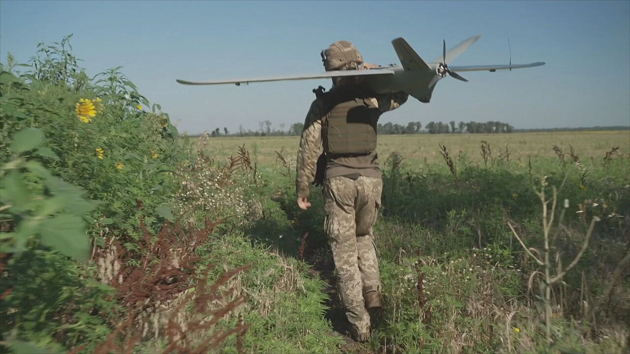(LONDON) — Ukraine is training thousands of drone pilots and ramping up its production of unmanned aircraft to bring an “army of drones” to the front lines of its counteroffensive against Russia, Ukrainian military officials and manufacturers told ABC News in rare interviews on the secretive program.
From November through May, Ukraine has trained 10,000 drone pilots, and another 10,000 pilots are being trained right now, according to Ukraine’s minister of digital transformation, Mykhailo Fedorov.
“I want to use all means available to destroy the enemy and achieve victory. The Ukrainian Armed Forces get a lot of support from our Western partners, but we also have to develop our own technologies and use them on a scale never seen before in any conflicts,” a drone pilot said. The name of the pilot and location of the facility are being withheld for safety and security reasons.
For the Ukrainian Armed Forces, drone warfare is already proving to be indispensable on the battlefield.
Some drones spy on Russian positions, identifying targets that are then hit by artillery and mortar fire. Others are attack drones, dropping ordnance or exploding on impact, killing Russian soldiers hiding in trenches, blowing up tanks on the front lines, striking artillery pieces hidden in tree lines and hitting stockpiles of munitions and key supply lines.
One year ago, there were only seven manufacturers making drones in Ukraine. Today, there are at least 80 of them, according to Dmytro Kovalchuk, CEO of drone manufacturer Warbird.
Kovalchuk embodies the entrepreneurial spirit driving this quiet revolution. In one year, he says he’s gone from making just three drones a month to making 150.
“In Ukraine, not a single state enterprise is producing drones. It’s all private enterprises, sometimes partnerships,” Kovalchuk told ABC News.
“It costs $1,000 and can destroy a tank that costs $500,000. We are talking about the development of an army of drones,” Kovalchuk said.
Skyeton is one of the most advanced manufacturers of unmanned aerial vehicles, or UAVs. Its Raybird reconnaissance drone costs over $1 million and can fly for more than 30 hours at an altitude of over 16,000 feet, relaying real-time high-quality images of enemy positions deep into Russian territory.
Oleksandr Stepura, Skyeton’s founder and chairman, says UAVs need to be able to prioritize and identify targets.
“For us, tanks are not objects for recognition and for impaction. For us, it’s warfare systems, it’s artillery systems, air defense systems from [the] other side. So this is the object we’d like to recognize and destroy,” Stepura said.
The Raybird already has basic artificial intelligence built in, but developers are looking at a new generation that could totally transform warfare, Stepura said.
“[The] era of manned aircraft, in terms of Air Force, completely ended with this war,” Stepura said. “This war showed that to have the person inside of the flying bird, no reason to do that, no sense. The pilot doesn’t have time to think, never. Just milliseconds. And any machine will do that better than people…and faster and more accurately.”
This new army of drones is now taking the war to the heart of Russia in Moscow, showing Putin and Russians that the homeland is no longer immune from the war and that Ukraine has new longer-range drone capabilities.
ABC News obtained an image of the drone used in the latest Moscow attacks – a Bober long-range UAV.
A drone developer with intimate knowledge of this top-secret program agreed to talk to ABC News anonymously.
When asked about the psychological impact of the ability to strike inside Moscow or in Russian territorial waters, the developer said, “It’s very important for us. We showed them that two can play this game. It’s very important to make Russians know that we also have weapons. We also can attack them.”
“The more drones that are produced, the more attacks will be provided,” the developer said.
“My understanding of what the goals are is to have capability to strike all strategic aviation airfields, to push back strategic aviation capable of launching missiles,” the developer said.
It’s not just airfields and aviation, but also warships at sea. A new generation of maritime drones burst onto the scene with two recent attacks.
A Russian warship was struck inside its own territorial waters in July with a drone carrying almost 1,000 pounds of explosives. The following day, there was a strike on an oil tanker supplying Russian troops.
Ukraine did not admit to carrying out these particular strikes, but intelligence officials now tell ABC News that drones are being used to target Russia in the Black Sea.
Copyright © 2023, ABC Audio. All rights reserved.












